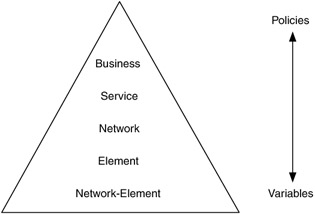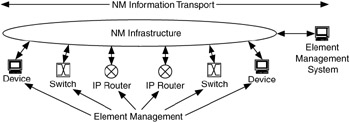7.4 Defining Network Management
7.4 Defining Network Management
Network management can be viewed as a structure consisting of multiple layers:
Business management: This is the management of the business aspects of a network, for example, the management of budgets/resources, planning, and agreements.
Service management: This is the management of delivery of services to users; for example, for service providers, this would include the management of access bandwidth, data storage, and application delivery.
Network management: This is the management of all network devices across the entire network.
Element management: This is the management of a collection of similar network devices, for example, access routers or subscriber management systems.
Network-element management: This is the management of individual network devices, for example, a single router, switch, or hub.
This structure is a top-down approach, with the most abstract component (business management) at the top of the hierarchy and the most specified, concrete component (network-element management) at the bottom of this hierarchy. This is shown in Figure 7.1.

Figure 7.1: Network management hierarchy.
Correspondingly, as the components become more abstract, the ways that they are applied and measured (their information elements) change. Thus, at the bottom of this hierarchy (network-element, element, and network), management is applied with variables and parameters, and at the top of this hierarchy (service and business), management is applied in more abstract terms, using policies. This is common to all architectural components, and we will find that policies can be used for each component.
Network management can be divided into two basic functions: the transport of management information across the system and the management of network management information elements (Figure 7.2).

Figure 7.2: Network management is composed of managing elements and transporting management data.
These functions, as shown in Figure 7.2, consist of a variety of tasks—monitoring, configuring, troubleshooting, and planning—that are performed by users, administrators, and network personnel. One of the first challenges in developing a network management architecture is to define what network management really means to the organizations that will be performing the tasks and receiving the end services—the users, or customers, of the system.
There are four categories of network management tasks that we will consider here, corresponding to the four tasks mentioned earlier:
-
Monitoring for event notification
-
Monitoring for trend analysis and planning
-
Configuring network parameters
-
Troubleshooting the network
7.4.1 Network Devices and Characteristics
A network device is an individual component of the network that participates at one or more of the protocol layers. This includes end devices, routers, switches, data service units (DSUs), hubs, and network interface cards (NICs). Network devices have characteristics that can be measured. They are grouped into end-to-end and per-link/per-network or per-element characteristics, as shown in Figure 7.3.

Figure 7.3: Network characteristics can be per element, per link, per network, or end-to-end.
End-to-end characteristics are those that can be measured across multiple network devices in the path of one or more traffic flows and may be extended across the entire network or between devices. Examples of end-to-end characteristics for network devices are availability, capacity, delay, delay variation (jitter), throughput, error rates, and network utilization. These characteristics may be modified or added to depending on the types of traffic on the network.
Per-link/per-network and per-element characteristics are those that are specific to the type of element or connection between elements being monitored. These characteristics may be used individually or may be combined to form an end-to-end characteristic. Examples of per-link characteristics are propagation delay and link utilization, and examples of per-element characteristics include (for an IP router) IP forwarding rates (e.g., in IP packets per second), buffer utilization for the router, and any logs of authentication failures.
Management of network devices and networks includes network planning (e.g., cell site planning for wireless), initial resource allocation (e.g., frequency or bandwidth allocations), and fault, configuration, accounting, performance, and security (FCAPS) from the telecommunication network management model.
EAN: 2147483647
Pages: 161